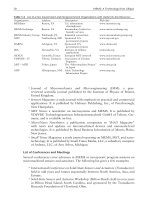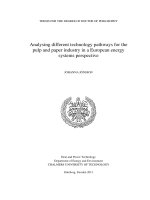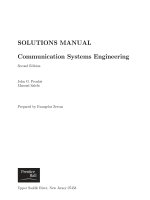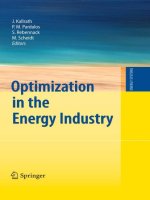64964386 0071495932 energy systems engineering vanek instructorsmanualvers1p1
Bạn đang xem bản rút gọn của tài liệu. Xem và tải ngay bản đầy đủ của tài liệu tại đây (971.88 KB, 121 trang )
www.elsolucionario.net
Instructor’s Manual
Francis M Vanek
Louis D Albright
Version 1.1, January 2009
First Edition (Version 1.0) September 2008
Last updated 1/5/09
McGraw-Hill Professional
New York
(Please send any comments or corrections to Francis Vanek at
www.elsolucionario.net
Energy Systems Engineering:
Evaluation and Implementation
www.elsolucionario.net
Contents
Notes about the Instructor’s Manual and Suite............................................................................... 3
Options for structuring a college course around the book .............................................................. 5
Sample syllabus .............................................................................................................................. 6
Sample Schedule of Homework Assignments for 1-Semester Course......................................... 10
Solutions to exercises.................................................................................................................... 12
Sample exam problems ................................................................................................................. 84
Answers to selected sample exam problems............................................................................... 100
LCR Tables ................................................................................................................................. 114
CF Tables .................................................................................................................................... 117
2
www.elsolucionario.net
Examples of topics of previous term projects............................................................................... 11
www.elsolucionario.net
Notes about the Instructor’s Manual and Suite
This instructor’s manual includes a list of options for structuring a course around the book, a sample
course syllabus, answers to all end-of-chapter exercises, sample exam problems with solutions, and LCR
and CF Tables for solar thermal analysis.
The sample syllabus is written for a 14 week semester with three 50-minute lectures each week. It can be
modified to fit other schedule formats. Out of 42 class meetings, 38 meetings are programmed in the
week-by-week schedule, leaving 4 meetings for guest speakers, student presentations, review sessions, inclass exams, or expanded coverage of some topics in the course. The instructor is encouraged to use the
sample syllabus as a template and adapt it to his or her own course.
Exam problems may consist either of short, closed- or open-book type problems (with the option of
providing key equations and parameters on a sheet to accompany the exam, in the case of a closed-book
test) or longer take-home problems that the student solves on her or his own. We provide examples of
both types.
For the exercises, refer to the accompanying spreadsheets for underlying details of calculations for each
problem (hyperlinks are provided). Instructors are encouraged to modify the exercises as they are posed
to the students in problem sets, both to meet individual goals for the course, and also to prevent posing
exactly the same problem from one year to the next. The spreadsheets are designed to facilitate these
sorts of modifications. Cells with key parameters are colored yellow, and cells with answers are green;
both are found at the top of the spreadsheet. Where the solver is used in a sheet, cells changed by the
solver are colored blue. For each exercise, the instructor should verify that changes in parameters flow
down through the spreadsheet and change the solution appropriately. Some manual changing of cells in
the calculation part of the spreadsheet will be necessary.
In some cases, comments have been added in a section at the bottom of some exercise to help the
instructor add depth to the problem that is being posed.
In situations where errors occurred in the presentation of parameters in the book as it was published, the
corrected values are given with a red background.
Many worksheets use the Excel Solver function to find the solution to a problem, so the security settings
in Excel should be set to allow macros to function.
In some cases, answers as written in the Instructor’s Manual have been shortened to three significant
digits, for brevity. Each instructor can of course decide their own standard for minimum number of
significant digits.
The teaching slideshow provides a basic framework for teaching an energy course based on the book,
with enough material to take up some but not all of the lecture time available in a one-semester course.
This is intended to allow the instructor to add slides as a reflection of their background and interest in
teaching. One source of additional slides is the set of book slideshows, since there are a large number of
figures and tables from the book that do not already appear in the teaching slideshows. Also, the
approach that was used for the 2004 to 2006 versions of the course was to present all formuli, derivations,
proofs, etc on the blackboard or whiteboard, so that these do not appear in the teaching slideshow.
3
www.elsolucionario.net
In addition, there are the following supplementary materials that comprise the complete instructor’s
manual suite: 1) solution spreadsheet files, with one workbook per chapter and one worksheet per
problem, 2) a set of Matlab scripts used in select homework problems, 3) book powerpoint shows with all
figures and tables from the book, and 4) teaching powerpoint shows for teaching a complete one-semester
course.
www.elsolucionario.net
The instructor’s manual is provided in both Word and pdf format. Formatting errors may have been
introduced in the conversion from Word to pdf, so if in doubt, please refer to the Word version.
Instructors are welcome to copy and paste text from the manual in making up homeworks and solutions.
However, we prefer that the solutions be distributed in hard copy only, since this slows the further
electronic distribution of solutions to other students.
www.elsolucionario.net
Lastly, we are very interested in developing the best instructor’s manual possible for supporting your
teaching needs. If you have corrections or other feedback, please email Francis Vanek at
4
www.elsolucionario.net
Options for structuring a college course around the book
1.
2.
3.
4.
5.
6.
7.
8.
9.
10.
11.
12.
13.
14.
15.
Introduction
Systems tools for energy systems
Economic tools for energy systems
Climate change and climate modeling
Fossil fuel resources
Stationary combustion systems
Carbon sequestration
Nuclear energy systems
Solar energy resource
Solar photovoltaics
Solar thermal technologies
Wind energy systems
Transportation energy systems
Systems issues for transportation energy
Conclusion
For instance, the following course outlines are possible:
1. Course covering fossil, nuclear, and renewable energy, including transportation energy.
Incorporate chapters 1, 4-15 (skim chapter 2-3): This is the outline for the course presented in the
syllabus below. Independent reading of chapters 2 and 3 is required so that the material will fit in
the time frame of a single semester, according to our experience.
2. Course covering non-transportation fossil, nuclear, and renewable energy. Incorporate chapters 112, 15: exclude chapters 13 and 14, spend more time on chapters 2 and 3.
3. Course focusing on energy sources other than renewable energy: Incorporate chapters 1-8, 13-15
(skim 9 – 12). Since the chapters on renewable energy are quite detailed, have students
optionally skim these chapters, and focus more on stationary combustion, nuclear energy, and
transportation issues.
4. Course focusing on renewable energy sources: Incorporate chapters 1-4, 9-12, 15. There is
sufficient detail in chapters 9-12 to make an entire semester class around these materials.
Chapters 13 and 14 would be optional in this case.
The sample syllabus presented in the next section is written for a course that uses outline #1 above.
5
www.elsolucionario.net
The book can be used for a number of possible course formats, reflecting the interests of the instructor
and students. These courses are created using the following 15 chapter titles in the book:
www.elsolucionario.net
Sample syllabus
This is the syllabus used for a course entitled Mechanical & Aerospace 501, “Future Energy
Systems”, from 2004 to 2006.
Goals for the Course
1. The student will become proficient in engineering calculations of the performance and
rudimentary design of various energy conversion systems.
2. The student will become familiar with the physics of the environmental issues, including
the greenhouse effect and global climate change.
3. The student will become adept in the comparative analysis of various energy conversion
systems. The comparisons will include cost, social acceptability as well as environmental
consequences.
The course will draw on material studied in fluid mechanics, thermodynamics, heat transfer and
electronic theory. Students will study the basic theory of fuel cells, turbines, photovoltaic
devices, etc. and determine component and system efficiencies. Additionally, along the way,
students will become familiar with the relationship between ethical issues and the quality of our
environment, and the complex interplay between engineering systems and society, so the course
will provide a bridge between engineering and policy. The emphasis of the course is, however,
on application of quantitative engineering techniques to energy systems, as reflected in
objectives 1-3.
There is one more goal: in general, the intent is to apply a wide range of engineering skills to a
pressing challenge of our time, so one overall goal of the course is to “do something interesting,
and have fun.” I hope we will all succeed in this area!
Grading
The final grade is made up of the following components:
Homework:
Midterm exam:
Final project
Final exam
20%
25%
25%
30%
6
www.elsolucionario.net
The overall goals for the course are as follows:
www.elsolucionario.net
There will be eight homework assignments during the semester. Seven are standard problem
sets, usually due on Fridays and distributed two weeks in advance. Credit will be deducted for
late homework (barring medical or other circumstances) at the rate of 25% per day late, after
four days no credit will be given. Also, the lowest homework grade will be dropped from your
average.
I encourage classroom participation in the following way: at the end of course, a student with
good marks for participation who is just below the cutoff for a higher grade can be “bumped up”,
at my discretion.
Term project:
The course will include a term project to give students an opportunity to apply what they have
learned to a specific future energy system problem or challenge. Students will work in groups of
2 or 3 on the project and produce a final written report. Each project team will present their
work in a 10-12 minute presentation at the end of the semester.
A list of possible term paper topics and examples from the previous year will be circulated
separately. I will also upload files from 2004 and 2005 term papers for your review. The topic
of the project will be either the review of a technology or a specific project. The subject area can
be a topic of your own choosing, or you can choose one of the options I have identified in the
local community, such as with the university or a local government agency.
Course website
This course makes extensive use of a course website. All powerpoint files used in lecture,
homework assignments, and homework solutions are uploaded here. Powerpoint files will be
uploaded the week before they are presented in class, unless you are notified otherwise. Other
items of interest will be uploaded here as well.
Course textbook
7
www.elsolucionario.net
Current events: for the 8th homework grade, term project teams will take turns bringing in an
article from newspapers, magazines or the internet, to share with the class (i.e. each team will
have one turn during the semester, in an order drawn up by me). Presentations are at the
beginning of the lecture on Wednesday, starting in Week 2. As long as you present the article on
your allocated date, you get full credit for this homework.
www.elsolucionario.net
The required textbook for the course is Energy Systems Engineering: Evaluation and
Implementation by Francis Vanek and Louis Albright (Publisher: McGraw-Hill, New York)
Course schedule by unit and date
Note: key deadlines during the semester are given in bold.
Unit
Topic
Introduction. Outline of the course. Guidelines for how the material is approached.
Motivations
for studying future energy systems (e.g. pollution, climate change,
Lectures
energy security). Principles from engineering economics and systems engineering.
1-4
Team signups due 1/27. Reading: Chapters 1-3.
Modeling of atmosphere and global climate. Estimation of the effect of increased
Lectures greenhouse gases on global climate. Potential risks from climate change. Reading:
Chapter 4.
5-9
#2
Overview of fossil fuel combustion and plants. Comparison of fuels. Cycle analysis
#3.
Lectures (Brayton, Rankine review; combined cycles, cogeneration). District Heating.
10-13
Reading: Chapters 5-6. Course pack: S2. HW1 due. Term project proposal due.
Overall system efficiency starting from well/mine. Emerging sequestration
#4
Lectures technologies (biomass, mineral deposition, etc). Reading: Chapters 6 (continued) and
14-16
7. HW2 due.
Solar power: availability. Solar physics, solar radiation geometry, solar collection
Lectures and conversion for heating systems. Reading: Chapter 9
17-18
#5
Solar technology. P-n junctions. Materials. Photovoltaic cells. Solar
Lectures towers/heliostats. Solar thermal applications. Solar thermal design in buildings.
Reading: Chapters 10 and 11. HW3 due. Midterm exam, in-class + take-home
19-20
portions
#6
Nuclear power: current reactor designs, breeder reactors, nuclear fusion. Nuclear
Lectures waste disposal. Reading: Chapter 8. HW4 due.
21-24
#7
Wind industry and available energy: worldwide growth. Turbine capacity factor.
Wind
energy formation and availability. Statistical modeling of wind energy.
Lectures
Reading: Chapter 12.
25-26
#8
Wind turbine design. Tip speed ratio, Betz limit. Blade element theory. Operating
Lectures conditions (siting, height, wind speed variation, siting density). Land requirements.
Economics of wind energy. Reading: Chapter 12. HW5 due.
27-30
#9
#10
Transportation energy: overview of transportation applications, e.g. freight vs
8
www.elsolucionario.net
#1
www.elsolucionario.net
Lectures passenger. Advances in ICE technology. Prospects for battery powered vehicles.
31-33
Hybrid technology. Issues in energy for freight transportation. Reading: Chapters
13 and 14.
Transportation energy: hydrogen as a transportation fuel. Infrastructure
Lectures requirements. Distributed electric generation from vehicles. Techniques for
analyzing transportation energy trends: Divisia Analysis. Reading: Chapters 13 and
34-36
14. HW6 due.
#11
Overview of other emerging future energy technologies. Role of political process.
Summary
of course. Student presentations of term projects. Reading: Chapter 15.
Lectures
Term project due. HW7 due. Final exam (in exam room, open book).
37-38
Guest speakers:
There will be a limited number of guest speakers during the semester, to accompany coverage of material
in the course. The speakers are all practitioners in the areas of state-of-the-art energy system design, and
therefore the talks should be of great interest to the class and also to complement material presented in the
regular lectures. I am also asking each speaker to talk briefly about their career path, so that students can
learn about how they might enter the energy system field. Attendance at these talks is mandatory, and
material presented at these lectures is fair game for homeworks and exams (where possible, I will make
powerpoint shows available on the Blackboard site after the lectures).
Speakers and tentative dates:
1. Insert here as appropriate
Recommended journal readings:
The following readings are not required but are useful background for the introduction and the unit on
transportation energy:
•
•
Hoffert, M I et al (2002) “Advanced technology paths to global climate stability: energy for a
greenhouse planet” Science v298, pp.981-987.
Kreith, Frank, R.E. West, and Beth Isler (2002), “Legislative and technical perspectives for
advanced ground transportation systems.” Transportation Quarterly v. 56 no1 (Winter 2002) p.
51-73.
•
Lackner, K et al (1995) “Carbon Dioxide Disposal in Carbonate Materials”. Energy v20
n11, pp1153-1170.
•
Francis Vanek and Edward Morlok (2000). “Improving the energy efficiency of freight in the
United States through commodity based analysis: justification and implementation.”
Transportation Research Part D, Vol.5 No.1 pp. 11-29.
These papers and others to be recommended during the course of the semester are available from on-line
journal subscriptions of your college.
9
www.elsolucionario.net
#12
www.elsolucionario.net
Sample Schedule of Homework Assignments for 1-Semester Course
Homework
Problems assigned
1
1-5, 1-7, 2-4, 3-2, 6-1, 6-3
2
4-2, 4-3, 6-6, 5-1, 6-8, 6-9
3
7-6, 9-1, 9-2, 9-6
4
8-4, 8-6, 8-9, 10-2, 10-8
5
11-4, 11-15, 11-16, 12-1, 12-7
6
12-2, 12-3, 12-5, 12-10
7
13-5, 13-8, 14-2, 14-6, 14-7
In our experience, students taking these courses have a well-organized system of passing
solutions from one group of students taking the course to those taking it a year later. Posting the
identical problem sets from one year to the next poses the problem that students may have access
to the exact solutions to the problems. However, by either exchanging problems in the list above
with others in the book, or modifying the problems using the accompanying solution
spreadsheets, it is possible to minimize the possibility of plagiarism/cheating.
10
www.elsolucionario.net
The following schedule of assignments corresponds with the seven homework sets that appear in
the semester schedule in the sample syllabus above. For each of the seven sets, a list of
homework problems is given. Based on the level of the students in the class, an instructor might
add, remove or substitute problems from the list shown.
www.elsolucionario.net
Examples of topics of previous term projects
•
Solar energy in space
•
Ground source heat pumps
•
Converting waste to biofuel on the Cornell campus*
•
Feasibility of offshore windfarm in Rhode Island
•
Feasibility study of car sharing program*
•
Feasibility study of small-scale wind at Ecovillage at Ithaca community*
•
Advanced nuclear energy options
•
Small-scale renewable energy options for Sahel in Africa
11
www.elsolucionario.net
Below is a list of topics covered by student team term projects at Cornell University to fulfill
the term project requirement for an energy course. In the course, student teams were allowed the
option of studying either a technology or a project. They had to include technical, economic, and
environmental components in the project. They were given the option of either coming up with
their own topics, or using a suggested local project in or around Cornell. Below is a list of
sample topics (local projects marked with a *):
www.elsolucionario.net
Solutions to exercises
(Note: for each chapter, refer to calculations in supporting spreadsheet, e.g., “Chap1Solutions.xls” for
Chapter 1, etc. Hyperlinks to spreadsheets are provided for each chapter; these may take some adjustment
in the user’s file directory to work correctly – in MS Word, right-click on the link to edit the path.)
Chapter 1. Introduction
Short answers:
2. Open-ended discussion question; see below.
3. HDI = 0.736; Not in line with other countries
4. a) see figure, b) discussion question, c) r2 = 0.457, d) r2 = 0.0241, e and f) discussion questions
5. 33.9, 29.5, 18.9, 23.0 EJ
6. 98.6, 22.5, 38.8, 13.6 Quads
7. Rank order: India, China, US, Japan
8. 140.4, 248, 22.3, 30.8, 81.9 mtoe
9. See explanation below.
Detailed answers for select problems:
Problem 1.1.
Use the internet or other resources to chart the development of an energy technology, from its earliest
beginnings to the present day. Did the roots of this technology first emerge prior to the start of the
industrial revolution? If so, how? If not, when did the technology first emerge? In what ways did the
industrial revolution accelerate the growth of the technology? More recently, what has been the impact of
the information age (for example, computers, software, electronically controlled operation, the internet,
etc.) on the technology?
•
Answer: A variety of answers are possible. For example, for wind energy, the roots of the
technology predate the industrial revolution, dating back to the middle ages in Europe
and earlier to use of wind for grinding grain in China and the Middle East. The industrial
revolution made possible metallurgical techniques which in turn enabled the precision
fabrication of turbine blades, electrical components, etc., used in wind electric conversion
devices. Since the 1970s, information technology has been used computationally to
improve the shape of the turbine blades or operationally to integrate electricity from the
turbine into the grid.
•
Alternatively, for solar energy: solar energy predates the industrial revolution, in that the
use of passive solar design to heat buildings or keep them cool goes back to the Ancient
12
www.elsolucionario.net
1. Open-ended discussion question; see below.
www.elsolucionario.net
Greeks, the Chinese, and the Native Americans of the southwest. Also, solar drying of
clothes and food has been practiced since antiquity. The industrial revolution accelerated
the growth of solar energy by making possible metallurgical techniques which in turn
enabled the precision fabrication of experimental solar-powered, steam-driven devices
starting in the late 1800s. They also made possible home-sized solar water heating
systems for domestic hot water. Since the 1970s, information technology has been used
computationally to control the manufacture of solar panels, or to operate tracking systems
that optimize the position of solar panels relative to the sun.
Problem 1.2.
Solution: From studying the accompanying graphs, it is clear that the trend in the U.K. more
closely resembles that of the USA than that of China.
On the GDP side, both the US and UK have gradually been decreasing energy and CO2
emissions per unit of GDP produced, although the UK is somewhat more efficient than USA in
producing a unit of GDP. This is different from China, which saw dramatic reductions in energy
and CO2 emissions per unit of GDP between 1980 and 2000, although these are perhaps slowing
after 2000.
On the population side, energy consumption per capita is slightly up for the UK and US and CO2
emissions per capita are slightly down for the period in question. This suggests that both
countries are reducing the amount of CO2 per unit of energy consumed. China is much lower in
per capita measures than the other two countries, but is seeing an upturn in both since 2000, so
that it appears that in the most recent years China is moving in a different direction than the other
two countries. Since 1995 or so, China is growing a much larger middle class, so it is not
surprising that energy and CO2 might turn upward in this way.
In general, the shape of the figures varies little whether one compares the three countries in terms
of per unit of energy or per unit of CO2 emitted. The most profound change has been the
reduction in energy and CO2 per unit of economic activity in China. Compared to this trend, all
other measures have not changed as much.
Figures to accompany problem 1.2:
13
www.elsolucionario.net
Note to instructors: it may be preferable to provide the students with the raw data for the three
countries used in this exercise, if you wish to save them time on the data gathering and focus on
the calculations and analysis.
www.elsolucionario.net
120.0
100.0
GJ/$GDP
80.0
China
60.0
UK
USA
40.0
20.0
0.0
1985
1990
1995
2000
2004
9.0
8.0
7.0
kgCO2/$GDP
6.0
China
5.0
UK
4.0
USA
3.0
2.0
1.0
0.0
1980
1985
1990
1995
2000
14
2004
www.elsolucionario.net
1980
www.elsolucionario.net
400.0
350.0
300.0
GJ/capita
250.0
China
UK
200.0
USA
150.0
100.0
50.0
0.0
1985
1990
1995
2000
2004
25.0
tonneCO2/cap
20.0
15.0
China
UK
USA
10.0
5.0
0.0
1980
1985
1990
1995
2000
15
2004
www.elsolucionario.net
1980
www.elsolucionario.net
Problem 1.9. Based on the paper: Smith, H. (1936). “The Origin of the Horsepower Unit.” American
Journal of Physics, Vol. 4, No. 3, pp.120–122. According to Watt’s text, the horsepower is based on a
horse moving 2.5 mph and drawing 150 lbs of weight up a shaft (i.e., over a pulley, and ignoring
frictional losses in the pully). This is equivalent to 13,200 ft per hour, or, taking into account the weight
being lifted, 1.98 million ft-lb/hr, or 33,000 ft-lb/min. From www.onlineconversions.com, 1 ft-lb/min is
equal to 22.6 milliwatts. Multiplying out gives 33,000 x 0.0226 = 746 watts.
Chapter 2. Systems tools for energy systems. Calculations: Chap2Solutions.xls.
Short answers:
2.1. Discussion question, see below.
2.2. Discussion question, see below.
2.4. 256.5 EJ
2.5. a) 392.6 GJ/person; b) 3926 GJ/person at stabilization; c) 299 years, d) a = 1900, b)2350; e)
Discussion question, open ended answer.
2.6. Natural = 57, Synthetic = 66. Choice: natural.
Detailed answers for select problems:
2.1 This question is open-ended, so many different answers are possible. In general, complex projects
(such as the upgrading of part of a transportation system in an urban region) will favor the use of a
systems approach. Such projects, if the systems approach is not used or is used incorrectly or
inadequately, will often fall short of expectations. Simple projects, or ones that have a narrow focus (such
as a building remodeling project or a scientific experiment with a very specific focus) have little need of
the systems approach. Such projects can be found to succeed without it, and in cases where it is applied,
the participants may find themselves encumbered by its extra layers of work.
2.2. This problem is open-ended in the sense that the causal loop diagram could incorporate various
factors. Suppose that we limit it to three effects:
1. Consumer effect: consumers see other drivers with large SUVs and want their own.
2. Nuisance effect: large SUVs are eventually blamed for congestion and become unpopular.
3. Price effect: increasing fuel consumption drives up the cost of fuel, reducing affordability.
The following diagram is the result:
16
www.elsolucionario.net
2.3. 304.2 EJ.
www.elsolucionario.net
www.elsolucionario.net
17
www.elsolucionario.net
Chapter 3. Economic tools for energy systems. Calculations: Chap3Solutions.xls.
Short answers:
1. $156,561; the investment is viable.
2. a) NPV = -$136,975; b) credit = $0.0245/kWh.
3. CRF = 11%
4. NPV = $521,897
5. $97.06; $81.00.
6. Case 1 = $76 trillion; Case 2 = $13.5 trillion; Case 3 = -$540 billion.
Problem 3.2. Renewable energy power plant proposed project: financial analysis. Using the given data to
calculate the value of the annuity, the average power output from the plant is 50,000 watts, which
translates into 4.38 x 105 kWh per year, or $17,082 per year at 3.9 c/kWh. The formula for calculating
the PW of this annuity is
⎛ (1 + i )N − 1 ⎞
⎟
P = A⎜⎜
N ⎟
(
)
⋅
+
i
i
1
⎝
⎠
so plugging in A, I = 6%, N = 25, gives P/A = 12.78, P = $218.4. Similarly the factor for discounting the
salvage value from the future to the present gives P/F = 0.233, so the present value of this amount is
$4,660. Summing gives an NPV of -360K + 218.4K + 4.7K = -$139.7K.
Part b) To calculate the credit per kWh, annualize the NPV, i.e., -$139.7K / 12.78 = -$10.7K. This
amount must be offset with an equal positive amount each year, i.e., +$10.7K. Distributing this amount
over each kWh produced gives $0.0245.
Problem 3.4. Produce a table of annual cash flow and cumulative cash flow from a spreadsheet, as
follows:
Year
Cap
0$
Annuity
(8,000,000) $
Disc. Value
-
Cumulative value
$
(8,000,000) $
(8,000,000)
1$
-
$
1,480,271
$
1,383,431
$
(6,616,569)
2$
-
$
1,165,194
$
1,017,726
$
(5,598,843)
3$
-
$
1,190,591
$
971,877
$
(4,626,966)
4$
-
$
1,286,144
$
981,193
$
(3,645,773)
5$
-
$
1,318,457
$
940,042
$
(2,705,731)
6$
-
$
973,862
$
648,925
$
(2,056,806)
7$
-
$
1,108,239
$
690,155
$
(1,366,651)
8$
-
$
1,468,544
$
854,706
$
(511,945)
9$
-
$
1,105,048
$
601,073
$
89,128
10 $
-
$
851,322
$
432,769
$
521,897
The NPV is then the cumulative value at the end of the last year, i.e., NPV = $521,897.
18
www.elsolucionario.net
Detailed answers for select problems:
www.elsolucionario.net
Chapter 4. Climate Change and Climate Modeling. Calculations: Chap4Solutions.xls.
1.
2.
3.
4.
5.
6.
7.
8.
287.9 K
Ts = 278.7 °C, Ta = 243.1 °C
Mars = 3 K, Venus = 468 K
Using representative parameters: Mars Ts = 220.3 K, Ta = 135.1 K; Venus Ts = 257.8 K,
Ta = 229.5 K. Exact answers will vary depending on choice of parameters.
Value from solving eq.4-1 with T = 288 K is F = 390.1 w/m2. Value from summing flux
for wavelength values from μ = 1 to 100 microns is F = 388.2 w/m2. Thus as upper
bound on μ is increased, approximate value will approach 390.1 w/m2.
Number of grid points = 224,640.
T = 202.7 K.
a) 611.5 ppm, b) year = 2077, c) 3.0 Gt Carbon, d) plot below, e) The scenario stabilizes
relatively quickly, even though the concentration is high (610 ppm). Also, the IPCC
scenarios tend to have a "smooth landing" at the tail, whereas this scenario changes
abruptly. e) Sample answers: The assumption of constant absorption of CO2 by the
oceans. Also, the assumption of a "smooth" representation of policy. It is likely to be
more lumpy, and also to respond to the effects of climate change as they unfold. Other
answers possible as well.
Plot for Problem 4.8:
12
8
6
4
2
0
20
04
20
08
20
12
20
16
20
20
20
24
20
28
20
32
20
36
20
40
20
44
20
48
20
52
20
56
20
60
20
64
20
68
20
72
20
76
Net emissions [GtC/year]
10
19
www.elsolucionario.net
Short Answers
www.elsolucionario.net
Detailed answers to select problems:
Problem 4.1. The given initial temperature is 255 K. Plugging this value into equation 4-1 gives
F = σT 4 = 5.67 −8 ⋅ (255) 4 = 2.40 w/m2
If we add 150 w/m2 to the flux the new value is F = 390 w/m2. Solving for the new temperature
gives
0.25
(
= 390 / 5.67 −8
)
0.25
= 287.9 K
Problem 4.4. Solved for atmosphere of Venus; solution for Mars is similar. Temperature values solved
using Excel Solver and with suitable choice of parameters: ta= 0.15, αs = 0.13, α’s = 0.31, t’a= 0.03, C =
2.5. In the spreadsheet, each equation, for the surface and the atmosphere, has four terms (in rows);
summing down the columns gives the value of that equation. In the solver, the target cell is set equal to
the sum for the surface, and required that it equal zero; the atmosphere equation is then set equal to 0 as a
constraint.
Equations to encode in the solver are as follows. The general form, from Chapter 4, is:
ta (1 − α s ) S0 / 4 − C (Ts − Ta ) − σ Ts4 (1 − α a' ) + σ Ta4 = 0
(1 − α
a
− ta (1 − α s ) ) S0 / 4 + C (Ts − Ta ) + σ Ts4 (1 − ta' − α a' ) − 2σ Ta4 = 0
Substituting the appropriate coefficient values into the equations gives:
0.05(1-0.13)So/4 – 2.5(Ts - Ta) – σ Ts4(1 – 0.31) + σ Ta4 = 0
(1- 0.75 – 0.15(1 -0.13))So/4 + 2.5(Ts - Ta) – σ Ts4(1 – 0.03 - 0.31) - 2σ Ta4 = 0
These equations can then be plugged into the solver. Table used in the solver:
Temperature values:
T-s=
257.8
T-a =
229.5
20
www.elsolucionario.net
T = (F / σ )
www.elsolucionario.net
Equation:
Surface
Atmosphere
eq.1
eq.2
Term
1
86.07
78.82
2
70.66
70.66
3
172.79
165.28
4
157.38
314.75
0.00
(0.00)
Total
Discussion: No, the model is not effective! The actual surface temperature of Venus is hundreds of
degrees higher. This is probably due to the thick and dense atmosphere of Venus; it cannot be effectively
modeled by a model that has only one layer. The results of the model are not sensitive to the choice of
parameter values that are left to individual judgment (other than albedo and solar constant for Venus,
which are fixed). Changing these values does not greatly change the outcome of the model.
Problem 4.5. The solution consists of calculating the energy flux in w/m2 at wavelengths across a
range of values, and then approximating the energy flux for small increments as being constant.
Flux as a function of wavelength is calculated using eq.4-4:
Here C1 = 3.742 × 108 Wm3/K and C2 = 1.4387 × 104 mK. So, for example, for λ = 1 x 10-6 m,
the value of FBB is:
(
)
−5
3.742 × 10 8 1.006 × 10 −6 ⋅ 10 6
= 7.55 x10 −14 W/m 2
FBB (1.0 × 10 ) =
4
⎤
⎡ 1.4387 × 10
exp ⎢
− 1⎥
−6
6
⎣ 1.0 × 10 ⋅ 10 288 ⎦
−6
(
)
The rest of the solution can be calculated in a spreadsheet, an excerpt of which is shown here:
Wavelen
freq
flux
cumulative
[microns] [m]
[1/s]
[w/m2]
[w/m2]
1
1.00E-06 3.00E+14 7.55E-14 7.55E-14
2
2.00E-06 1.50E+14 1.66E-04 1.66E-04
3
3.00E-06 1.00E+14 9.03E-02 9.05E-02
21
www.elsolucionario.net
Answer: Surface temp = 257.8 deg K; Atmospheric temp = 229.5 deg K.
www.elsolucionario.net
etc
etc
etc
etc
etc
100 1.00E-04 3.00E+12 5.77E-02 3.88E+02
Note that for the range λ < 1 micron, λ > 100 microns, the flux values are small, so that if the
range of values in the range is extended beyond 1 < λ < 100 microns, the cumulative value will
only grow slightly and will approach FBB = 390.1 w/m2 asymptotically.
Chapter 5. Fossil fuels. Calculations: Chap5Solutions.xls.
1.
2.
3.
4.
5.
6.
In units of MJ/kgCO2: Butane = 16.48, Wood = 6.82, gasoline = 16.19, coal = 8.18.
Research question, open-ended answer.
a) 0.079 kg/mile, 2.973 MJ/mile; b) 0.0991 kg input, 0.363 kg CO2 released.
a) year 2027, b) 32.8 billion barrels/year, c) year 2119.
97%
69%
Detailed answers to select problems:
Problem 5.1. Note that molecular mass of CO2 is 44.
Butane (C4H10): molecular mass of butane: 58. Reaction: C4H10 + 6.5 O2 > 4CO2 + 5 H20. Thus
one molecule of CH4 yields four molecules of CO2. Ratio of molecular masses: 4*44/58 =
3.034. MJ per kg butane is 50 MJ. Energy per unit of carbon released: (50 MJ/kgCH4) / 3.034 =
16.48 MJ / kgCO2.
Wood (CH2O): molecular mass of wood: 30. Reaction: CH2O + O2 > CO2 + H20. Thus one
molecule of wood yields one molecule of CO2. Ratio of molecular masses: 44/30 = 1.47. MJ
per kg butane is 10 MJ. Energy per unit of carbon released: (10 MJ/kg wood) / 1.47 = 6.82 MJ /
kg CO2.
Gasoline (C8H18): molecular mass of gasoline: 8 * 12 + 18 = 114. Reaction: C8H18 + 12.5 O2 > 8
CO2 + 9 H20. Thus one molecule of Gasoline yields 8 molecules of CO2. Ratio of molecular
masses: (8 * 44)/114 = 3.09. MJ per kg Gasoline is 50 MJ. Energy per unit of carbon released:
(50 MJ/kgGasoline) / 3.09 = 16.19 MJ / kg CO2
Coal (C): molecular mass of coal: 12. Reaction: C + O2 > CO2. Thus one molecule of Coal
yields one molecule of CO2. Ratio of molecular masses: 44/12 = 3.67. MJ per kg Coal is 30 MJ.
Energy per unit of carbon released: (30 MJ/kgCoal) / 3.67 = 8.18 MJ / kg CO2.
Problem 5.4. As explained in Chapter 5, let S be the shape parameter for the Hubbert curve and tm the year
in which the maximum occurs. Then for each year t, the value of Pest can be calculated using Eq. (5-1), as
follows:
22
www.elsolucionario.net
Short answers:
www.elsolucionario.net
P=
[
Qinf
exp − (t m − t ) 2 /(2S 2 )
S 2π
]
(5 - 1)
The data on actual production are given in the spreadsheet “Chap5solution.xls”. We have used a solver to
find values S = 42.6 years and tm = 2027 that minimize RMSD. As examples of how RMSD is calculated,
the appropriate values for calculating RMSD for select years (1910, 1940, 1970, 2000) are given in the
following table:
1910
1940
1970
2000
Pactual
(109 barrel)
0.1
2.1
16.8
25.0
Pest
(109 barrel)
0.7
4.0
13.2
26.8
(Pactual – Pest)2
0.4
3.6
12.4
2.68
Summing the square of error terms for all 107 values from years 1900 to 2006 gives a value of 447.2.
The value of the RMSD is then calculated using Eq. (5-2).
RMSD =
1
(447.2) = 2.044
107
Answer to part a): year of maximum is 2027.
Part b) to calculate output in 2027, substitute Qinf = 3.5 trillion, S = 42.6 years, and tm = 2027 into Eq. (51) gives
P=
3.5 × 1012
42.6 2π
exp(0) = 3.27 × 1010 bbl
Part c): 10% of the peak output value is 3.27 billion barrels. This value occurs in the year 2119. The
value can be confirmed using eq.5-1:
P=
3.5 × 1012
42.6 2π
exp(−(2027 − 2119) 2 /( 2 ⋅ 42.6) 2 ) = 3.26 × 10 9 = ~ 3.27 × 10 9 bbl
Chapter 6. Stationary combustion systems. Calculations: Chap6Solutions.xls.
Tip to instructors: for problems in this chapter and elsewhere involving Rankine or Brayton cycles,
students should be required to produce a table of enthalpy and/or entropy values by state in the cycle.
Such a table facilitates grading solutions in the event that the student has made a computational error
and is receiving partial credit.
Short answers
1. 42.1%.
2. 6.94 x 109 MJ/y; $69.4 million per year; 381,000 tonnes CO2; 545 tonnes / million kWh.
3. 30.2%.
23
www.elsolucionario.net
t
www.elsolucionario.net
4. 3.04 x 1010 MJ/y; $36.5 million per year; 3.72 million tonnes CO2; 1,769 tonnes / million kWh.
5. thermal efficiency 46.5%; Carnot efficiency 67.2%.
6. 71.7%
7. a) 48.2%; b) 37.8%; c) 62.1%; d) 423,000 kW; e) 220,000 kW; f) 10.1%
8. a) 15,300 kW; b) 25,200 kW; c) 64.7%; d) 2.17 x 108 kWh/year.
9. 16.1 tonnes CO2 per hour.
10. a) $ 0.14/kWh; b) $ 0.094/kWh; c) 900 hours per year.
11. a) 6 PM; b) $193,000 and YES; c) 30% of demand; d) $344,000.
Problem 6.1. From the tables: h1 = 295.2, pr1 = 1.386, h3 = 1277.8, pr3 = 238. Based on the pressure ratio
of the cycle,
pr2 = pr1 x 8 = 11.09,
and since the value of pr at T = 540 is 11.2, we can say that T2 = ~540, h2 = 544.3. For state 4:
pr4 = pr3 / 8= 29.75
Interpolating in the air table between T = 700 and T = 710 gives pr700 = 28.80, pr710 = 30.38, T = 706, h4 =
719.7. Solving for work and heat in:
wc = 544.3 – 295.2 = 249.1
wt = 1277.8 – 719.7 = 558.1
qin = 1277.8 – 544.3 = 733.5
and thus efficiency is (558.1 – 249.1) / 733.5 = 42.1%
Problem 6.2. Use overall plant efficiency and required output of electricity to calculate energy input in the
gas. The overall efficiency for the plant is the product of efficiency of combustor, turbine, and generator:
Effoverall = (0.88)(0.421)(0.98) = 36.3%
700 million kWh of electricity is converted to units of MJ as follows:
⎛ 3.6MJ ⎞
9
Energy = 7 x108 kWh ⋅ ⎜
⎟ = 2.52 x10 MJ
kWh
⎝
⎠
Therefore the total energy input required is 2.52 x 109 MJ / 0.363 = 6.94 x 109 MJ
Part b) Annual expenditure on gas is 6.94 x 106 GJ x $10/GJ = $69.4 million
Part c) CO2 emissions: from Chapter 5, combustion of 18.2 MJ of gas equivalent releases one kilogram of
CO2. Therefore total emissions are
24
www.elsolucionario.net
Detailed answers to select problems:









